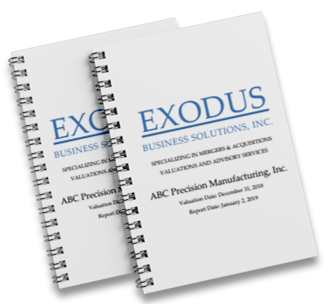Contact us at Exodus HQ by submitting a business inquiry
Exodus delivered on what they said they were going to do in our first meetings. It was a pleasure working with their team to sell my company. They are truly experts in aerospace/defense manufacturing.

Going into the market with a clear understanding of your company value is a key element of preparing and exit strategy. Would you sell your house without understanding the true value?
Exodus Business Solutions employs a world class team of financial analysts, holds accreditation from the National Association of Certified Valuation Analysts, and performs hundreds of formal Valuations for transactional purposes each year.
Our Valuations are comprehensive yet affordable; providing the analysis necessary to understand fair market value. Each document is certified and signed by a licensed CVA.
We do Valuations for
Transactional Purposes
Partnership Dissolution
Employee Stock Ownership Plan (ESOP)
Bank Financing
Exit Strategy Planning
Wealth Management & Family Trust
Strategic & tactical planning
Our Valuations will allow you to:
- Understand the true value of your company
- Prepare a reliable exit strategy
- Add a key component to your business plan
- Recognize bank financing options
- Assign shareholder value
- Work with your advisors regarding wealth management and tax planning
Strategy development

Exodus NACVA Certified Valuation Reports
Strategic plan development
What we cover
Our comprehensive Executive Summary’s are typically 17-20 pages long and provide a full overview of the company, ownership, industry, competitve advantage, products / services, and more. This is an introduction to the business with key facts provided before the financial analysis.
We take the time to understand which products / services are driving sales and if there are any customer concentrations. This is done for a full 5 years and broken down annually.
An overview of the facility and location with reference pictures, zoning information, terms of lease, and operating hours.
A list of equipment and property necessary to maintain business operations.
Comparative and adjusted balance sheets showing the retained assets by the seller and transferrable assets to the buyer. Furthermore, we provide key metrics related to the comparative balance sheet.
5 years of profit and loss statements with adjustments to reflect the true earning power of the business. A trailing 12 months and Pro Forma are included.
A 5 year review of the company’s operating history. This information is often used to predict future profitability.
A compilation of several analysis showing the value based on company assets.
This exhibit converts the probable subjective view of the Risk, Stability and other factors into a numeral that should represent an appropriate Capitalization Rate (Risk/Reward Ratio) for the business.
The discount and capitalization rates represent the risk an investor is willing to accept for the potential reward an investment in the subject company will return. Different rates apply to types of businesses.
This exhibit describes the historic financial performance to obtain a level of comfort as to probable earning power in the form of Adjusted EBITDA and Seller’s Discretionary Earnings.
The following is an income-valuation approach that determines the value of a business by looking at the current benefit of realizing a cash flow now, rather than in the future.
This method, sometimes referred to as “Present Value of Future Earnings,” uses projected earnings for a period of time and then calculates the present value of these earnings and terminal value.
This method projects present earnings over a period of time and then calculates the present value of these earnings.
This method blends the values of assets and earnings to determine the value of a business.
The market approach develops a value using the principle of substitution based on similar companies that have recently been transferred.
This exhibit measures the probability of obtaining third party financing.
In this exhibit we justify the purchase price by making sure the deal can pay the new owner a fair living wage, service the debt used to purchase the business, and cover capital expenditures.
A hypothetical view into likely transaction structure.
